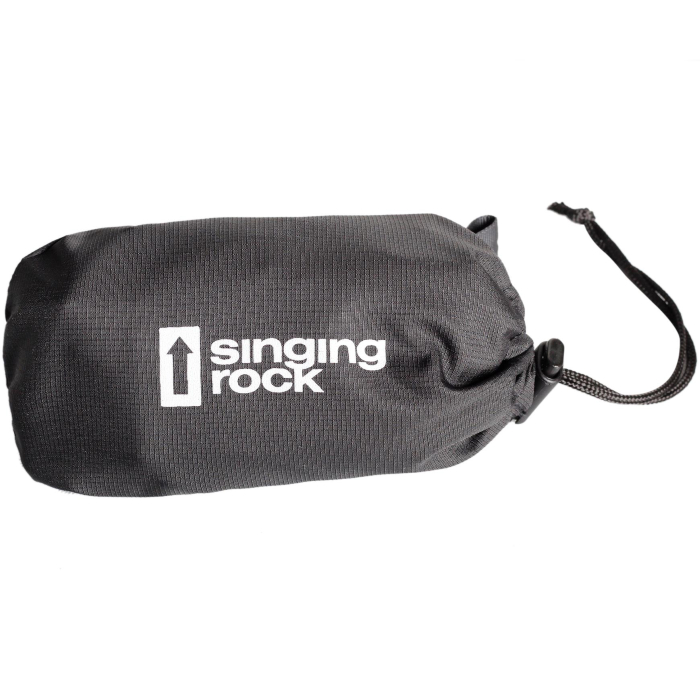How to use Singing Rock harness, storage and maintenance with instructional pictures.
Serac
Description
Extremely lightweight harness for ski touring, mountaineering and glacier tours.
- can be put on/off safely and quickly with skis/crampons on, with feet on the ground
- construction made of HMPE (high-modulus polyethylene) lace webbing which is super lightweight and strong
- fine nylon fabric inside the harness doesn´t absorb water and it is very breathable
- tying in two color distinguished tying loops with a strength of 15 kN
- opening and adjusting the leg loops with the patented 12 mm wide Rock&Lock aluminium buckle, easy and fast manipulation even with the gloves on
- two gear loops with a load capacity of 5 kg, each gear loop is divided into 3 sections which allow easier gear management
- gear loop is made of thin webbing and long enough that doesn´t restraint when wearing a backpack
- two slots for the additional plastic carabiner PORTER to carry ice screws or other gear
- rear haul loop with a load capacity of 5 kg
- two elastic loops on each leg loop for comfortable carrying an ice screw
- transport bag included
- this harness is designed for demanding mountaineering and skitouring with minimal weight under 100 grams and super packable size
Retail price
This Product is Hard to Find.
We don’t know where you can buy this item online in the US. We’ll continue to check all the major retailers and will update this page as soon as we find one.
If you know where to find this online in the US, let us know, and we’ll add the link.
Weight (g)  WeightIn grams, the weight, as stated by the manufacturer/brand. If there are differences in weight (due to multiple sizes or optional accessories) we'll list them here. The default weight is the middle-most size, often this is size M. | 96 g S : 92 g / 3.2 oz
M : 96 g / 3.4 oz L : 99 g / 3.5 oz XL : 102 g / 3.6 oz XXL : 106 g / 3.7 oz
(weight converted from grams to ounces) |
| Fit | Unisex |
| Sizes | XS, S, M, L, XL, XXL |
Gear Loops  Number of Gear LoopsGear loops are used to hold gear (quickdraws, cams, etc) onto your harness. 4 gear loops is most common. 
0 - 1 Gear LoopsMost often on full body harnesses or guide/gym style harnesses. 2-3 Gear LoopsMostly found on lighter harnesses made for [ski] mountaineering or high-end sport climbing where weight is a high priority. 4 - 5 Gear LoopsThe standard/most common number for climbing harnesses. Perfect for sport and trad. More Than 6 Gear LoopsDesigned for long multi-pitch and big wall climbing, found on harnesses made to hold the maximum amount of gear. Worth ConsideringOccasionally, the number of gear loops will change on a harness model depending on the size. There could be 7 gear loops for the med/large but only 5 gear loops for the xsmall/small. In this case we list the highest number for the filters, and then write an explanation on the product page like, “Size S/XS can only fit 5 gear loops.” | 2 Gear loops |
Ice Clip Slots  Ice Clip SlotIce clipper slots are made to fit a carabiner that holds ice screws. These slots are generally only used by ice climbers but there is no disadvantage to having them on your harness. 
Less than 40% of harnesses will have ice clipper slots. And those harnesses will usually have 2 or 4 slots, often located next to, or between, the gear loops. | Yes, 2 |
| Belay / Tie-In | Tie-In |
| Waist Buckle Type | Clip |
| Leg Buckle Type | Clip |
| Drop Seat | No |
Haul Loop  Haul LoopTrad climbers often look for a haul loop as they're intended to haul a rope (second line) or pack (while you climb the chimney). 
A haul loop can also hold shoes or other accessories. Although not the intended use, it is also commonly used to hold a chalk bag. | Yes (0kN) |
| Certification | CE, EN, UIAA |
| Size Chart | S (will fit the upper range of XS) |
No reviews yet.
A pictoral representation of UIAA-105 and EN-12277 standards for harnesses.
The UIAA equipment standard provides a baseline for equipment performance in a test lab under controlled conditions on new equipment. Although these test conditions are relevant to the conditions encountered climbing, conditions encountered at the crags and the condition of the equipment are equally important. This recommendation from the UIAA member federation The British Mountaineering Council (BMC) provides vital equipment information that is NOT explicitly addressed in the standard, particularly failure modes of the equipment and recommendations for the use, inspection, maintenance, and retirement of equipment.
































